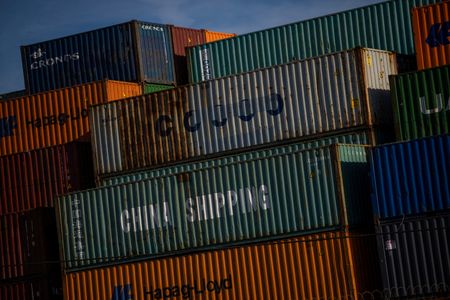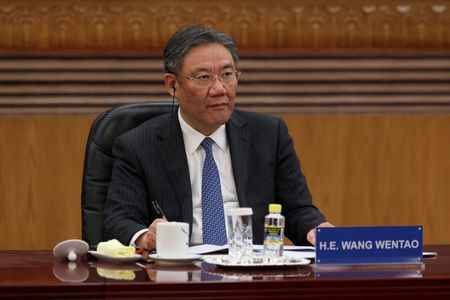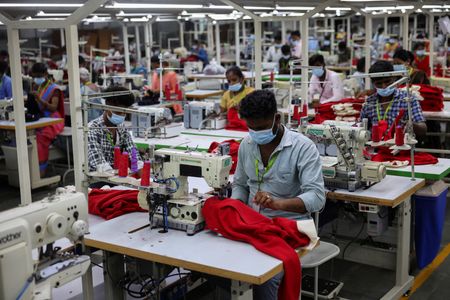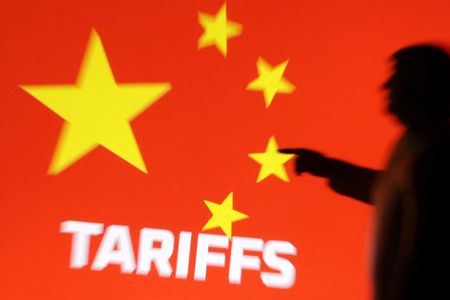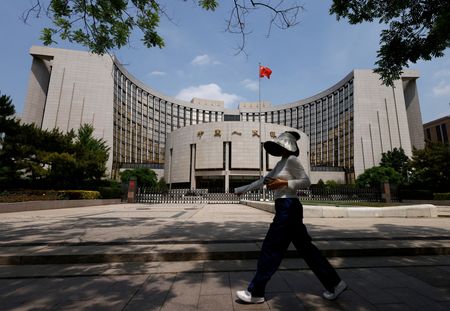By Joe Cash and Yukun Zhang
BEIJING (Reuters) -China’s exports beat forecasts in April, buoyed by demand for materials from overseas manufacturers who rushed out goods to make the most of U.S. President Donald Trump’s 90-day tariff pause.
The world’s two largest economies have been locked in a bruising tit-for-tat tariff war and businesses on both sides of the Pacific will be looking for some kind of resolution at closely watched trade talks in Switzerland this weekend.
Customs data on Friday showed outbound shipments from China rose 8.1% year-on-year in April, beating a forecast 1.9% increase in a Reuters poll of economists but slowing from the 12.4% jump in March.
Trump announced sweeping “reciprocal tariffs” of 10% on April 2, before offering a pause for most countries while the White House worked on multiple trade deals. China, however, was excluded from the reprieve and singled out for levies of 145%, kicking off a protracted cat-and-mouse game that has rattled global markets and upended supply chains.
Chinese manufacturers had also been front-loading outbound shipments in anticipation of the duties, but are now banking on ice-breaker tariff talks between American and Chinese officials in Geneva on Saturday.
Imports fell 0.2%, compared with expectations for a 5.9% drop, suggesting domestic demand may be holding up better than expected as policymakers continue to take steps to prop up the $19 trillion economy.
“The ASEAN countries are speeding up their production to meet the July deadline, the 90-day negotiation break. Their production is highly reliant on China’s exports in raw materials and industrial inputs, so China’s exports got support,” said Dan Wang, China director at Eurasia Group.
“Over the next two months, China’s exports could continue to be strong due to industrial capacity relocation, but the trade data could deteriorate quite quickly if the 145% tariffs on China are still in place and ASEAN countries’ talks (with the Trump administration) don’t make progress,” she added.
Exports to Southeast Asian countries rose 20.8% in April.
China’s exports to the U.S., meanwhile, fell 21%. That meant the trade surplus with the U.S. dropped to $20.5 billion from $27.6 billion in March, a win for Trump, who has repeatedly said he wants to narrow the gap.
HIGH STAKES
Beijing cannot afford a trade war with the U.S. but sees Trump’s tariffs as unwelcome interference, with officials wanting to implement the painful domestic reforms needed to shore up long-term growth at their own pace.
If not lowered or removed, the tariffs could deal a heavy blow to China’s economy, which has relied on exports to drive growth as it struggles to recover from the pandemic shocks and a protracted property market slump.
“The damage of the U.S. tariffs has not shown up in the trade data for April,” said Zhiwei Zhang, chief economist at Pinpoint Asset Management. “I expect the trade data will weaken in the next few months gradually.”
“Hopefully, the trade negotiations between China and the U.S. can reach agreement soon and bring down tariffs to mitigate the shock to global trade,” he added.
Beijing has in the past few months reiterated its confidence that China could achieve the “around 5%” growth target for the year, and rolled out measures to bolster consumption and support the country’s exporters.
A slew of monetary stimulus measures, including liquidity injections and cuts to policy rates, was announced on Wednesday in a bid to ease tariff hits on the economy.
For now, the trade sector’s momentum is still riding on the global scramble to make the most of Trump’s brief tariff relief.
China’s steel exports topped 10 million metric tons for a second straight month in April, as top customers like South Korea and Vietnam bought in bulk to outrun the tariffs, which analysts expect to disrupt China’s lucrative transhipment trade.
With global copper producers rushing stocks to the U.S. after Trump proposed slapping levies on the metal, China’s imports of unwrought copper and copper products remained unchanged last month.
Soybean imports plunged to a 10-year low in April, but this was due to prolonged customs clearance delays and late Brazilian shipments caused by harvest slowdowns and logistics issues.
(Reporting by Joe Cash and Yukun Zhang; Editing by Sam Holmes)

